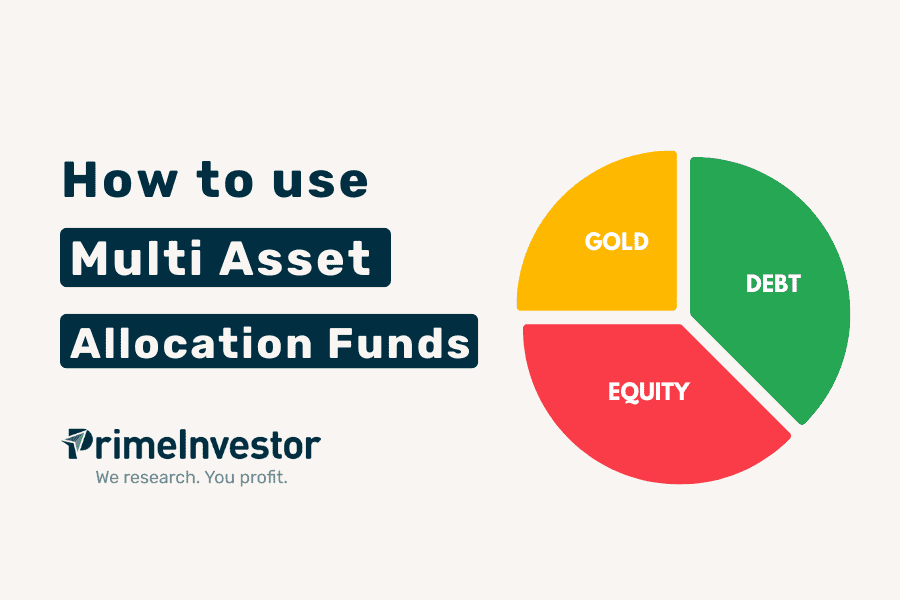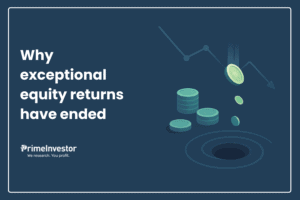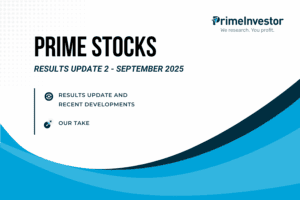As the advertisements go, investing in a multi asset allocation fund is a simple way to get the best of the three primary asset classes – equity, debt, and gold. And then you can sit back, forget about which asset class you should invest in, and let the fund take care of it for you.

That is true – but not entirely. As is always the case with hybrid funds, the devil lies in the way these funds allocate between the asset classes. This impacts what you use these funds for and their suitability for you. In this report, we’ll explain how multi asset allocation funds are structured, how they have performed and how you should use them in your portfolio.
Where multi asset allocation funds invest
Emerging from SEBI’s 2017 fund categorization, multi-asset allocation funds are a relatively new segment. Out of 25 current funds, only 9 have a track record spanning more than three years.
By SEBI’s definition, a multi asset allocation fund needs to invest at least 10% in at least 3 asset classes. SEBI doesn’t specify which asset class, but obviously it would be equity, debt and commodities (primarily gold) – the only asset classes allowed in mutual funds. Theoretically, the intention was that funds would dynamically change the allocation between the three based on their comparative attractiveness.
Then came the drastic changes in taxation of funds that held less than 65% in equity. This forced some multi asset allocation funds into remaining equity oriented instead of dynamic, while others chose to maintain 35% equity, and still others stuck to the more dynamic movement. As these funds stand today, here are broad buckets into which multi asset funds can be fitted:
Equity oriented: These funds maintain a 65% equity allocation through a nuanced approach. Rather than simply shifting to debt or gold during market volatility, they use derivatives to manage risk dynamically. This strategy, similar to balanced advantage funds, allows for more nuanced market exposure while preserving core equity positioning.
Funds such as HDFC, Mirae and Tata are especially heavy users of derivatives to bring down equity exposure. Derivative exposure of HDFC Multi Asset Allocation, for example, swung between 13 to 20% in the past 2 years. Mirae Asset Multi Allocation is at similar levels.
As a result, funds of this type do not see much swing in their debt or commodity allocation. They, however, serve the purpose of bringing down equity risk when called for.
Equity-heavy allocation: These are the aggressive multi asset funds. They are different from the above bucket in terms of the extent of equity exposure they take. These funds use very less derivatives (based on their portfolios so far). Pure, unhedged equity in these funds is usually more than 60-65% with some such as Baroda BNP Paribas taking it even higher to 70-75%. Nippon Multi Asset is also along similar lines. In these funds, where debt and commodity allocation are also low, they are, in reality, less multi-asset and more equity-oriented.
Balanced allocation: These funds shift allocations to each asset class based on their outlook in equity, debt, & gold with higher mandated gold allocation in some. They may undertake different strategies in both equity and debt. These funds do not maintain a 65% equity allocation but usually have at least 35% in equity, therefore avoiding the inefficient debt taxation (but neither will they enjoy equity taxation).
For example, White Oak Multi Asset has seen debt move between 30 to 45% in the past year or so. Equity has remained steady around 35% with gold making up a solid 19-20% at times. Similarly, SBI Multi Asset Allocation fund has seen debt as high as 47%.
Funds of this type, therefore, seek to derive returns from the individual asset class moves, – be it in equity, debt or gold (or other commodities) much more than other multi asset funds.
Good commodity allocation: These are funds that go beyond the mandated 10% allocation to the third asset class. Regardless of what they are doing with their equity and debt exposure, these funds use commodities such as gold quite significantly. These funds see commodity exposure at 13-15% or even higher. BNP Paribas Multi Asset, for example, can go up to 25% in gold as per its mandate.
Of late, several funds have silver in their portfolios in addition to gold as well. ABSL Multi Asset, for example, has upped silver to about 5% of its portfolio. Along with a approx. 10% exposure in gold and a 4% holding in REITs, this fund has about 20% in assets outside of equity and debt. Multi asset funds from Axis, Edelweiss, Kotak, and Bandhan are others that have latched on to silver.
Funds with good commodity exposure use this asset not just as a minor diversifier but tactically as a return driver as well.
Apart from the groupings explained above, there are those which are an absolute hop out of kin – like Edelweiss Multi Asset Allocation fund that entirely hedges equity and holds only active debt and commodity exposure. But by and large, a multi asset allocation fund should fit into at least one of the buckets above. The table below lists all the multi-asset funds available today and their average equity, debt, derivative and commodity exposure since January 2023 (or later, depending on the fund’s launch date)
How returns stack up
In general, multi asset allocation funds need to be able to contain downsides better than pure equity. Returns will obviously be lower than equity or even aggressive hybrid in the long term. An important point to note when it comes to returns is that most multi-asset funds do not have enough history to judge performance. Therefore, any assessment we make is based on available performance data and can change in the future as market cycles change and funds establish themselves.
Volatility is lower for the category on an average, compared to aggressive hybrid aggressive and large-cap funds, given that equity is lower. The ‘multi presence’ advantage of these funds can be seen in their higher returns owing to both debt and gold, which has especially been a higher-returning asset of late. The 1-year return of the category has beat the Nifty 50 a good 70% of the time in the past 3 years! Much of the outperformance has come in 2024 and in the low-returning phases of the index such as late 2022.
Multi asset allocation funds sit between balanced advantage and hybrid aggressive funds in terms of volatility risk and returns.
- The multi-asset category average beats the hybrid aggressive average about half the time on a rolling 1 year return basis for the past 3 years. The average outperformance margin is a good 7 percentage points given that aggressive hybrid funds have both a naturally higher equity allocation and since they picked up mid and smallcap stocks in the past few years. In terms of volatility, though, multi asset funds are much lower.
- Compared to balanced advantage funds, multi asset funds category almost always deliver higher returns. Both volatility and loss propensity are higher.
On downside containment, multi asset funds do well. Based on rolling 1 month returns over the past three years, the average downside capture works out to about 38% compared to the Nifty 50 index (i.e., the category on an average declined only 38% as much as the Nifty 50). Individual funds, of course, are higher or lower depending on their strategy and portfolio.
The table below shows where the multi asset category stands compared to others in terms of risk and returns.
How to use multi asset allocation funds
The portfolio and return picture, so far, show that multi asset funds offer reasonable risk-adjusted returns compared to pure equity funds. Multi asset funds vie with both hybrid aggressive and balanced advantage funds as options to add in your portfolio.
Therefore, there are 5 key points to understand about using multi asset allocation funds first.
- These funds do not dramatically shift between equity, debt and gold. As explained above, quite a few funds stick to equity orientation and are more akin to lower-risk equity than multi-asset in the way you may think. Similarly, not all funds have significant commodity exposure.
- These funds cannot be used to introduce asset allocation in your portfolio. One, asset allocation is individual based on your risk and timeframe and a fund cannot meet such individual criteria. Two, the fund may adopt a very different view of the market compared to what you may want. For example, if you think equity markets are expensive at this point and want a multi asset fund that will reduce equity, the fund may in fact be doing the opposite. Motilal Multi Asset, for example, has been raising equity exposure in the past few months. Three, for an individual fund to influence your portfolio asset allocation, the weight you give it needs to be very high – which is a risk in itself.
- Each fund is different in its approach and you need to know clearly what the fund does. Otherwise, you may wind up picking a fund that is unsuitable for what you want. For example, Edelweiss Multi Asset is a very low risk fund that won’t let you ride on equity market returns. ICICI Pru Multi Asset adopts an equity orientation but is very measured in the risk it takes. Bank Of India Multi Asset is debt-heavy.
- Whatever the approach of the fund, look at its performance first. This seems a bit obvious, but fund performance is not uniform even when allocations may be similar. Therefore, if a fund’s allocation meets your requirement, look at how it returns compared to similar funds before investing. Axis Multi Asset, for example, may be dynamic in its allocation, but fares poorly on both downside containment and returns. In the Prime Ratings for these funds, we use metrics to measure the risk and allocation these funds take, in addition to return metrics. We do this to account for the asset differences between funds but to also see whether ultimately these translate into returns.
- Multi asset funds are not substitutes for debt exposure. They are even less suitable for getting debt exposure than equity savings or balanced advantage funds.
With that said, here’s how you can use multi asset allocation funds in your portfolio.
Shorter holding period: Steer clear of these funds for 2-3 year periods. Equity savings and balanced advantage funds are more appropriate for shorter timeframes, as multi-asset funds' higher equity exposure can lead to suboptimal returns and increased risk.
Longer holding period: These funds are suitable for long-term portfolios for the following purposes.
- One, if you want to add equity exposure with lower risk; this is suitable for any investor.
- Two, if you want to diversify your already large portfolio without adding too many funds.
- Three, if your investment amount is not large enough for you to undertake asset allocation through pure equity and pure debt funds.
- Four, if you have lumpsums to invest in volatile or expensive markets, but you are wary about going for pure equity funds.
For the last two purposes, multi asset funds are more suitable than hybrid aggressive funds.






10 thoughts on “How to use Multi Asset Allocation funds”
How do they compare to Flexi caps? When should one consider investing in multi-asset funds vs flexi caps?
They are not comparable to flexi caps as flexicaps are purely equity funds. They come higher on the risk scale. thanks, Vidya
It might be interesting to compare these on performance with Asset allocation FoFs. Apart from the fact that they are to be held for 2 years for LTCG at 12.5%, do you see any disadvantages of FoF such as Kotak asset allocator FoF Dynamic over the funds that you have covered here? The fund from Kotak that I have mentioned here has a long track record and has performed well!
The disadvantage is that you’re depending in turn on the performance of the underlying funds’ performance and the choices of funds that the FoF picks. Not all equity funds or debt funds within an AMC are good investments. It’s an added level of uncertainty…if the underlying fund(s) don’t do well and you can’t control whether the FoF continues to invest in or what weight it gives. Unlike an underperformer in your individual portfolio, where you can choose to exit or stop fresh investments etc. It also incorporates the individual funds’ expense ratios 🙂 We don’t see the benefit in FoFs, when you can just invest directly in the funds yourself. – thanks, Bhavana
Get your point, thanks!
Madam,
Thanks for another insightful article.
On PI, the fund details provide the proportion of debt, equity and Others (commodities). What I really request for is for PI to provide the proportion of ‘Others’ in MAAFs.
Otherwise the details are just too generic for users to understand the difference between various MAAFs.
Thanks! You can find the allocation details in the MF Screener. In the individual fund page, it will be in the pie chart shown below the equity & debt instrument details. We note the suggestion that commodities can be shown separately, will see if that can be done. – thanks, Bhavana
Nice article about MAF at an appropriate time. Equity portion of the MAF is also very different For eg DSP MAA fund has quite some amount in foreign equity. This provides some diversification within the equities. Others like ICICI MAF has commodities futures like Gold, Silver, Aluminium, Copper, Crude Oil apart from REITS & InvIT’s.
One of the best DAA funds to invest for the long term in these markets. Any reason why TATA multi asset was left out, also the returns over a 1,3,5 ,10 yr period would be a value add
Do you mean Prime Funds, with regard to Tata Multi Asset? We prefer ICICI Multi Asset to it, because it has delivered consistently better and has better downsides and volatility as well. We have not given point-to-point returns here….we’ve given average 1 year returns since it is more relevant. Besides, many funds have a very short history. So for even 3 years returns, there is no data to show. You can check Prime Ratings or go to the individual fund’s page for more return data. – thanks, Bhavana
Comments are closed.